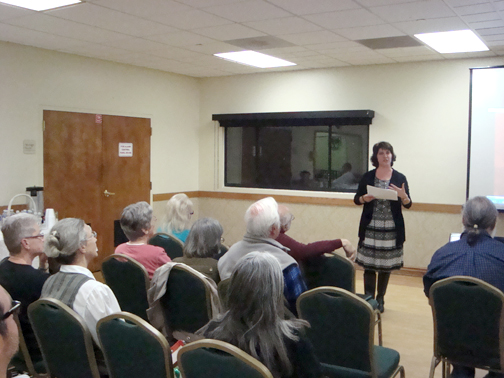The Montrose/Verdugo City/Sparr Heights Neighborhood Association (MVSNA) held its annual meeting Thursday night with the primary topic being the pros and cons of Sparr Heights becoming a historic district.
Lorna Vartanian, chair of the Glendale Historic Preservation Commission, visited residents at the Sparr Heights Community Center and explained the process that a neighborhood must go through to attain historic district status. Officially, there are 12 steps to becoming a historic district within Glendale, many of which include reviews by multiple city panels and thorough discussion with the residents of the proposed district through surveys and public meetings.
Vartanian said that before submitting an application for historic district status, an initial survey of the neighborhood was “highly recommended to see what the level of interest is.”
Petitions would be circulated among the neighbors two times throughout the official process, with designated block captains going door-to-door homeowners within the proposed district. Communication with the residents was identified as key as some will undoubtedly be resistant.
“Education is going to be a big, big part of the process,” said Vartanian. “You’re going to get some interesting feedback, but it’s all part of the process.”
Vartanian highlighted some common misconceptions about historic district status that she observed in the past from public surveys of residents, including homeowners thinking they would be told what changes could be made to the interior and backyards of their houses and that their homes would be subject to mandatory public tours. Vartanian said that the only parts of homes that would be scrutinized are those parts visible from the public right-of-way, which would exclude the interiors and backyards.
Public outreach was identified as one of the greatest challenges in pursuing a historic district. Not only will some residents be resistant, but many are simply hard to reach. One rule states that everyone on title in a home must sign the petition and meeting only one half of a couple is common during the petition process.
In addition, couples may disagree, which is problematic when both parties need to agree to sign off on the petition. Numerous others simply never answer the door, said Vartanian.
In addition to meeting with residents, the Planning Dept. and Historic Preservation Commission will need to review the application and hold public meetings. If recommended to go forward, block captains will need to go door-to-door again to see if residents will allow a historic resources survey to be conducted. At least 25% of the residents in the area must approve a historic resources survey, which would be conducted by a consultant hired by the city. The consultant must find that at least 60% of the homes in the area be considered “contributors” or homes that meet the characteristics of historic significance.
Another petition would be sent out after the historic resources survey and another review by the Historic Preservation Commission, this time targeting 50% of the homeowners to approve moving forward with historic district status. This would be followed by three more reviews, with the final determination being made by the Glendale City Council.
Vartanian described the historic district process as “challenging, but also very rewarding.” She stated that there were multiple benefits to achieving historic district status.
“The point is to protect the character of the neighborhood,” said Vartanian. “With a historic designation, when people want to make changes, they have to go through a process.”
Vartanian addressed another misconception, that this would create an additional level of bureaucracy for those seeking to make changes to their homes. In a historic district, homeowners will not need to consult with the Design Review Board when making changes, only the Historic Preservation Commission, which follows “award winning design guidelines,” said Vartanian.
She added that there are no explicit tax benefits from becoming a historic district, but said “there are statistics across the nation that talk about how property values in historic districts either retain or increase their value.”
MVSNA President Grant Michals emphasized that the MVSNA was not taking an official position either way and that no application has been submitted to the city.
“We’re just trying to start the discussion,” said Michals. “We’re looking to hear back from the neighbors of Sparr Heights.”
If started, the process is fairly lengthy, potentially taking up to three years according to Vartanian.
The city of Glendale currently contains six historic districts.

